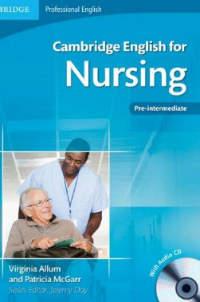Régulièrement, cette rubrique animée par Virginia Allum, auteur et consultante EMP (English for Medical Purposes), vous permettra, exercices à l'appui, de parfaire votre anglais médical au travers de situations de soins concrètes. Bon travail à tous !
N'hésitez pas à vous servir du dictionnaire en ligne Wordreference
Vous trouverez à la fin de cet article les corrections des exercices qui vous sont proposés téléchargeables au format pdf
Talking about vital signs : What are vital signs ?
Vital signs are also called Patient Observations. They include temperature, pulse, respirations and blood pressure. They may also include a patient’s oxygen saturation levels. Vital signs are taken when a patient is first admitted into the hospital as a baseline record. Baseline vital signs are important for doctors and nurses to understand what is normal for each particular patient.
Nurses record the readings on a Vital Signs chart making sure that they hand over information about abnormal baseline observations. The patient’s vital signs are recorded regularly while they are in hospital. Recording vital signs helps to monitor a patient’s condition after an operation and may also be used to detect early warning signs of health problems, for example fever.
Normal vital sign ranges are the results which are expected for an average healthy adult taken while the person is resting. Temperature, pulse, respirations and blood pressure readings all use different measurement scales but are usually written using a number value only. For example, a blood pressure of 110/70 , not 110/70mm/Hg.
Activity 1
Worth knowing
| Vital sign | measured as | normal limits |
|---|---|---|
|
Blood pressure |
mm/HG |
90/60 - 120/80 |
| Temperature Temp. |
°F or °C 1°C = 33.8°F |
97°F to 99°F 36°C to 37.5°C |
| Respirations Resps |
breaths per minute | 12-18 twelve to eighteen |
| Pulse | beats per minute | 60-100 sixty to one hundred |
| Oxygen Saturations sats |
% percentage of saturated oxygen in the blood | 97%-99% ninety-seven to ninety-nine per cent |
1°C = 33.8°F
Read the text ‘What are vital signs?’ and complete the following statements. Choose from the words below.
breaths ; normal ; monitor ; over ; range ; baseline ; point ; abnormal ; beats
The first vital signs which are taken when a patient arrives on the ward are called __________ vital signs.
Nurse hand over information about _______________ (not normal) baseline observations.
Vital signs help to _____________ ( keep an eye on) a patient’s condition after an operation.
An average healthy adult is expected to have _________________ vital sign ranges if they are measured during a resting period.
A blood pressure of 90/60 is measured in millimeters of mercury and spoken as ninety _______ sixty.
A pulse of 80 means eighty _____________ (of the heart) per minute.
Respirations are measured as ________________per minute.
Temperature may be measured using the Fahrenheit or Celcius scale. Normal body temperature is between thirty-six degrees to thirty-seven _____________five degrees Celcius.
Oxygen saturation of 98% is within the normal ___________for a healthy adult.
Activity 2
Grammar Focus : Talking about numbers with a decimal point.
Be careful to use the word ‘point’ when you talk about numbers such as 36.5 (thirty-six point five). A comma is used when writing thousands e.g 2,000 = two thousand.
How would you say the following numbers ; write them in words. The first one is done for you.
38.2 ° C thirty-eight point two degrees
37.3 ° C ___________________________________________________
36.9 ° C ___________________________________________________
35.4 ° C ___________________________________________________
Activity 3
Handing over information about Vital Signs
Nurses frequently give colleagues information about patient care. This is often done during a Nursing Handover. This is the time between nursing shifts when staff from the shift which is finishing ‘hands over’ their patients to staff on the next shift. Nurses often use abbreviations of terms when they speak to colleagues.
Abbreviations of Vital Sign terms:
BP blood pressure
Temp temperature
Resps respirations
Sats oxygen saturation
There are two ways to express Vital Signs – His BP’s……. (easier) or He’s got a BP of…. (more difficult).
For example:
His BP is 115/75
He’s got a BP of 115/75
Look at the handover notes below. Nurse Julie wants to remember the Vital Signs of her patient so she can hand over the information to her colleagues. Complete the information using the numbers below.
37.40 ; 76 ; 14 ; 168/100 ; 98%
Patient: Jim Greenway
His BP is ______________________
His pulse is ____________________
His resps are ___________________
His temp is ____________________
His sats are _____________________
Activity 4
Grammar Focus: singular or plural?
Which terms take the plural form of the verb (are) and which terms take the singular form (is) ?
BP ; Pulse ; resps ; Temp ; Sats
| singular - is | plural - are |
|---|---|
Activity 5
Equipment used to take a patient’s blood pressure
| Manual BP monitoring | Digital BP monitoring |
|---|---|
|
|
|
Complete the descriptions of manual and digital BP monitors. Use the terms below to help you.
bulb ; finger-nail ; cuff ; monitor ; stethoscope ; heartbeat ; digital ; cuff
| Manual BP monitoring | Digital BP monitoring |
|---|---|
|
Parts: Place ________around patient’s upper arm |
Parts: Place _______ around patient’s upper arm |
Activity 6
Grammar Focus: Remembering phrases
It’s a good idea to learn the verb which ‘belongs’ to a medical term rather than just learning the term in isolation. Here is a list of common expressions you will use to describe taking a patient’s vital signs :- take a blood pressure
- take a pulse
- do a patient’s resps (respirations)
- take a temperature
- do a sats reading
Complete the following sentences
Can I _______________ your blood pressure, please?
I’m going to check your vital signs in a minute. Do you mind if I _________________ your temperature?
I’ll put this oximeter clip on your finger and _____________ your sats reading.
You had a fever earlier today so I’ll ________________ your temp now to check it.
Can you please hold up your arm so I can _______________ your pulse?
He’s breathing very slowly so it would be a good idea to ____________ his respiration rate.
Activity 7
Communication Focus: Talking about abnormal vital sign results
Medical terms :
- hyper : high
- hypo : low
- tachy : fast
- brady : slow
Abnormal results may be expressed as too high or low or too fast or slow. You’ll find these prefixes are often used to talk about abnormal body functions. It’s a good idea to keep a notebook with a glossary of medical terms (prefixes and suffixes) to help you to memorize them. Medical terms have been borrowed from both Latin and Greek languages and can be difficult to remember at first, however, you’ll find that the same prefix or suffix will be used many times over so once it is learned it will be see again and again.
Complete the definitions of abnormal terms :
low ; fast ; high ; low ; slow
Hypertension means _____________blood pressure.
Hypotension means ______________ blood pressure.
Tachycardia means a ______________ pulse.
Bradycardia means a ______________pulse.
Hypothermia means a _____________temperature
Activity 8
Complete the table below by adding the medical terms in the final column. The first one is done for you.
| Element | Normal result | Abnormal result | Medical term |
|---|---|---|---|
| Blood pressure -tensio |
Normal | High blook pressure Low blood pressure |
Hypertension |
| Pulse -cardia |
Regular | Fast pulse Slow pulse |
|
| Respiration -pnoea |
Regular | Slow resps fast resps |
|
| Temperature -thermia |
Normal | High temperature Low temperature |
Activity 9
A note about talking about temperature and respiration
Hyperthermia means high temperature. It’s more common to use pyrexia or fever or say he’s got a fever or he’s pyrexical.
Tachypnoea means fast breathing. It’s more common to use fast breathing or say ‘he’s breathing very fast’
Bradypnoea means slow breathing. It’s more common to use slow breathing or say ‘he’s breathing very slowly’
Grammar focus : Pronunciation
The prefix –tachy is pronounced using a /k/ sound (ch=k)
The suffix –pnoea is usually pronounced with a ‘silent p’. An alternative spelling of –pnea is also used.
Nurse Julie is telling a colleague about her patient’s vital signs. Complete the dialogue using the words below.
tachycardia ; pyrexical ; breathing
“I’ll tell you about Mr Brown in bed 8 before I go home. I just took his temperature and he’s still______________. His temp was 38.5. He’s also _____________very fast, around 18 breaths a minute and he’s got __________________of around 90 beats per minute. I’ve called the doctor to come and see him straightaway.”
Activity 10
Text : The dangers of blood pressure and pulse abnormalities.
Most of the time a patient with hypotension has other health problems as well. The symptoms of low blood pressure include dizziness, headaches and difficulty breathing. Patients may also have a rapid pulse and complain of chest pain. Low blood pressure usually means that a patient has kidney or heart problems and can be as serious as hypertension.
Tachycardia causes the heart itself to beat faster which makes it harder for the heart to pump blood to the rest of the body. Patients are advised to see their doctor if their pulse rate is over 83 beats per minute as they may need to take medication to slow their heart rate.
Of course, it is normal to expect the heart rate to increase after exercise but if tachycardia continues after resting, it should be reported to a doctor. Tachycardia affects blood pressure readings and can also cause atherosclerosis or the formation of hard plaques on artery walls. When these plaques break off, they can cause blockage of blood vessels which may also cause heart attacks if the blockage is complete.
Answer the following statements True or False about the text above.
|
1 Low blood pressure can be the cause of a person feeling lightheaded. 2 Hypertension is a more serious condition than hypotension. 3 Tachycardia means a slow pulse rate. 4 A fast heart rate can be regulated by taking medication. 5 Tachycardia is always a serious health concern. |
True / False True / False True / False True / False True / False |
Activity 11
Medical Focus: equipment to take patient Observations
11 A - Match the equipment (1–5) to the definitions (a–e).
|
1 blood pressure cuff 2 digital blood pressure monitor 3 pulse oximeter 4 scales 5 tympanic thermometer |
a takes a patient’s blood pressure b wraps around a patient’s arm to take blood pressure c takes a patient’s temperature d recordsa patient’s blood oxygen saturation e weigh a patient |
11 B - Match the pictures (1–5) below to the equipment in Exercise 4a.
Télécharger les corrections au format PDF
Virginia ALLUM
Author and Consultant in English for Medical Purposes
United Kingdom








REFONTE DE LA FORMATION
L'idée d'un tronc commun en master hérisse les infirmiers spécialisés
ÉTUDES
D’infirmier à médecin : pourquoi et comment ils ont franchi le pas
VIE ÉTUDIANTE
FNESI'GAME : l'appli qui aide les étudiants infirmiers à réviser
PRÉVENTION
Des ateliers pour préserver la santé des étudiants en santé